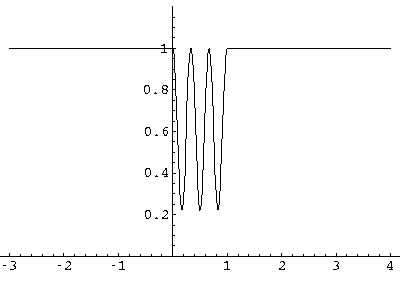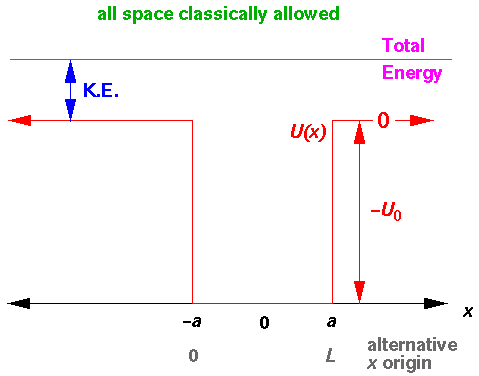
In order to study these states it's convenient to change the origin of energy. We'll shift all our energies up by the height of the well, so the top of the well becomes E=0 and the bottom of the well is -U0. Shifting the zero of energy does not in any way change the states we found on the previous page, it just shifts the energy we assigned to them.
This is our new set-up for our square well:

Our aim here is do consider states with E>0,
i.e., states with energies above the top of the well.
Classically a particle moving along the x-axis from the left
has constant kinetic energy (and hence speed) until it reaches
the well. While on the first well wall
(i.e., at x=0) the particle would experience a force
accelerating it. It would move through the well at a constant
speed faster than it had on the approach. When the particle hit the
far wall it would experience a force slowing it to its
original speed. The particle would then continue on its way
to x=+ . Pretty dull: straight-line
motion, simply moving faster when "in" the well.
. Pretty dull: straight-line
motion, simply moving faster when "in" the well.
Schrödinger's equation is still as before:
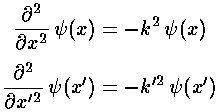
with well known solutions:

Note: outside the well U(x) is zero so:
k'2=E'
Inside the well we have more kinetic energy (and therefore momentum) so:
k'2=E'+U0'
By the definition of wavelength for a trigonometric function:
k=2 /
/ .
Thus we have a shorter wavelength inside the well than out.
Since
.
Thus we have a shorter wavelength inside the well than out.
Since  k is the particles momentum,
we have more momentum (and more kinetic energy) inside the well
than outside.
k is the particles momentum,
we have more momentum (and more kinetic energy) inside the well
than outside.
As before we have different formula for the wavefunction inside and outside
the well (different k means different functions). The
game is to match
 at the well sides. Before we proceed,
notice a nasty problem: we are going to have a sine or cosine wavefunction
(or linear combination of the two) outside the well. Thus
at the well sides. Before we proceed,
notice a nasty problem: we are going to have a sine or cosine wavefunction
(or linear combination of the two) outside the well. Thus
 will not go to zero for large x
and hence the solution cannot be normalized. There is no nice way
out of this problem, instead here are four solutions, each one with
problems:
will not go to zero for large x
and hence the solution cannot be normalized. There is no nice way
out of this problem, instead here are four solutions, each one with
problems:
 (x+L)=
(x+L)= (x)
(x)
where L is some huge distance much bigger than any imaginable thing. In the absence of any forces, we can then get a discrete set of normalized wavefunctions:

I imagine this all sounds pretty outlandish, but it actually is a commonly used technique.

In writing down orthonormality conditions we made a lot of use of the "Kronecker
delta"  that is 1 if i=j
and zero otherwise. Now we invent the "Dirac delta function",
which is kind of like the Kronecker delta, except for real numbers
rather than just integers.
that is 1 if i=j
and zero otherwise. Now we invent the "Dirac delta function",
which is kind of like the Kronecker delta, except for real numbers
rather than just integers.

The faint of heart (perhaps like your math TA) may blanch at these equations.
Evidently the Dirac delta function is zero except at
at single point (x=a), but the area under that point is 1!
It must be
that in some sense:  (0)=
(0)= .
If we use the Dirac delta in our normalization:
.
If we use the Dirac delta in our normalization:

we can have "normalized" functions that integrate out
to  .
.
The following relationship is very useful in making Dirac-delta normalized functions:

 ). What we need
is a measure of beam current: the number of particles
going by per second (we'll call this the flux). Since
the particles are conserved, we need a relation between the
probability density and the beams which move the probability around.
(This is analogous to E&M where we had charge density and current density.
There was a "continuity" equation that said:
"if the charge density is changing it is being fed by a current density".)
One can show that the following flux satisfies a continuity
relation with our probability density.
). What we need
is a measure of beam current: the number of particles
going by per second (we'll call this the flux). Since
the particles are conserved, we need a relation between the
probability density and the beams which move the probability around.
(This is analogous to E&M where we had charge density and current density.
There was a "continuity" equation that said:
"if the charge density is changing it is being fed by a current density".)
One can show that the following flux satisfies a continuity
relation with our probability density.

We begin by considering a wavefunction that is an eigenfunction of the momentum operator and hence has constant momentum:
 =Aeikx
=Aeikx
Plugging into the above definition for flux j, we have:

This relation should make sense. The momentum of the particle is
p= k; p/m is the velocity
v. We find that that flux is the probability density times
the velocity (just as in E&M the current density was the velocity times
the charge density).
k; p/m is the velocity
v. We find that that flux is the probability density times
the velocity (just as in E&M the current density was the velocity times
the charge density).
Note that the flux is a constant even through
the wavefunction is an oscillating function of position. Since
the wavefunction is an energy eigenfunction (i.e., a solution to
the time independent
Schrödinger's equation), the probability density
| |2 doesn't depend on time. So
the flux continuity equation says that that div(j)
is zero. In just one dimension we have:
|2 doesn't depend on time. So
the flux continuity equation says that that div(j)
is zero. In just one dimension we have:

In our problem we expect to have both an incident beam of particles and a reflected beam of particles on the left side of the well. To the right of the well we expect a transmitted beam. Inside the well, we'll just use a linear combination of Schrödinger's equation solutions. We use here non-dimensionless variables and the alternative x origin with lhs well-wall at x=0. Our piece-wise solution with unknown constants A, B, R and T:

If we calculate the flux with this wavefunction we find:
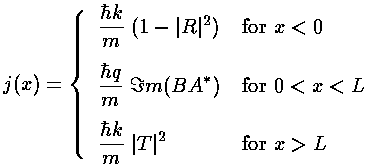
Notice that the flux for x<0 has a simple interpretation: the incident beam is moving to the right (+1), the reflected beam is moving to the left (-|R|2). Notice that all of these fluxes are just constants with no x dependence. Continuity requires that they be the same constant, so we learn, for example, that:
1-|R|2=|T|2
Now the reflection probability should be the reflected beam current divided by the incident beam current:

We're now set to match wavefunctions and wavefunction derivatives at x=0 and x=L:

At this point I've eliminated unknowns T and R, and I've left you two equations to solve for the two unknowns A and B. After solving for A, you can find R=A-1

Here is a display of the resulting reflection probability (where highly reflecting is white and non-reflecting is black) in the natural coordinates of the problem.
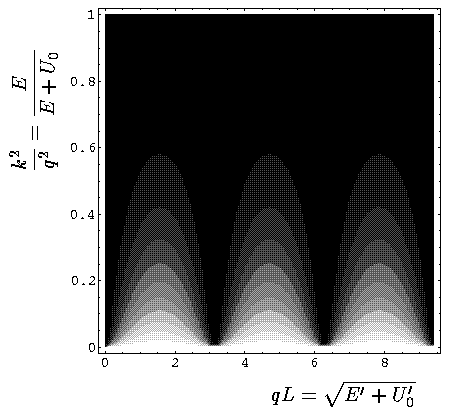
Here is a display of the reflection probability in terms of the natural experimental quantities E' U0':
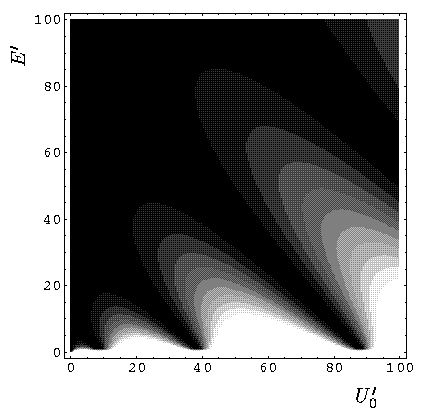
Recall that classically there is no reflection. In addition
there is no reflection in the WKB approximation. Thus the non-zero
reflection probability is a result of a non-WKB potential, i.e., one that
changes substantially in one wavelength of the particle. We see the
expected classical result of no reflection only for large energy, when
E>>U0. Note the zero reflection when
qL=n , i.e., when the infinite
square well version of the finite well has a bound state at the energy
of the incoming particles. Experimentally one might hope to see oscillations
in reflectivity just by raising the beam's energy. From the second plot see
that it is difficult to get more than one good oscillation just by
raising the beam energy.
, i.e., when the infinite
square well version of the finite well has a bound state at the energy
of the incoming particles. Experimentally one might hope to see oscillations
in reflectivity just by raising the beam's energy. From the second plot see
that it is difficult to get more than one good oscillation just by
raising the beam energy.
Since the wavefunctions are complex they are difficult to display as a x-y plot. We begin by displaying the real part of a low-energy (k2/q2=.5/7=.067) fairly reflective (|R|2=.64) wavefunction.
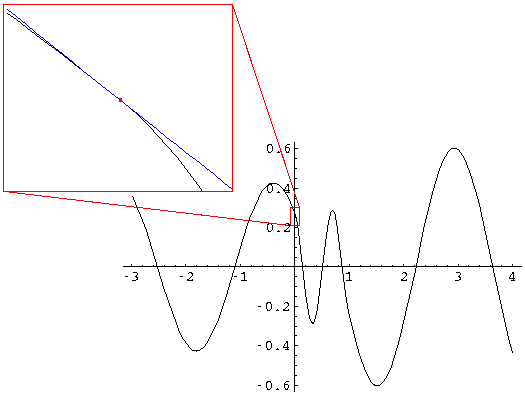
Note: the larger wavelength outside of the well. You may have thought
you saw a slope miss-match at x=0. The insert shows that the
slope is matched and that the second derivative of  is much more negative inside the well compared to outside. The fact that
the amplitude is bigger for x>L than for x<0
may lead you to the incorrect conclusion that the transmitted wave
is larger than the incident and/or reflected wave. If we displayed the
imaginary part of
is much more negative inside the well compared to outside. The fact that
the amplitude is bigger for x>L than for x<0
may lead you to the incorrect conclusion that the transmitted wave
is larger than the incident and/or reflected wave. If we displayed the
imaginary part of  , you would see the
oscillations for x<0 have a larger amplitude than those
for x>L. This difference is cleared up by looking at the
below probability density plot:
, you would see the
oscillations for x<0 have a larger amplitude than those
for x>L. This difference is cleared up by looking at the
below probability density plot:
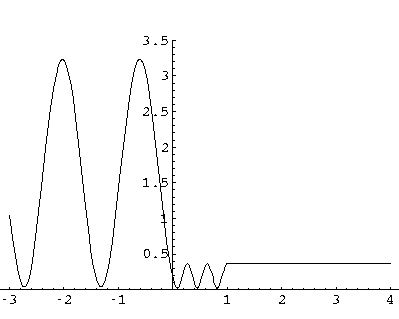
The probability oscillations for x<0 are the result of interference between the incoming and the reflected waves. It may look like the probability density actually goes to zero, e.g., near x=-1.3, but in fact the incoming and reflected waves cannot exactly cancel, since |R|<1. The minimums are (1-|R|)2=.04. The transmission probability looks to be a lot smaller than its actual value: |T|2=.36. Constructive interference between the incident and reflected wave makes the probability density large for x<0.
If we raise the energy, we can achieve the "resonant" zero reflection
situation (k2/q2=2/7=.286,
qL=3 ). Here is the real part of the wavefunction:
). Here is the real part of the wavefunction:
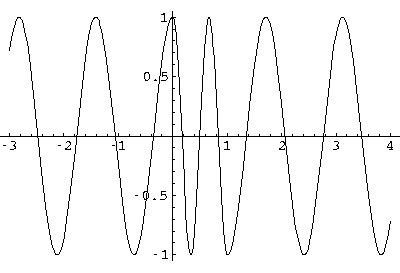
Here is the probability density:
